Tuesday June 3, 2013
Hartwick Pines State Park
Grayling, Michigan
We have a 7am appointment at the Visitor’s Center
The center normally doesn’t open until 10am this time of year but for those of us going on the Kirtland's Warbler walk it is ready for business at 7:00. Nine people meet Allison, our young guide, and see a short film about the extraordinary efforts being made to preserve the young jack pine habitat that the Kirtland’s must have for nesting. All of the information about the Kirtland’s in this post is from the film we saw and the State of Michigan’s Website.
The endangered Kirtland's warbler is one of the rarest members of the wood warbler family. It nests in just a few counties in Michigan's northern Lower and Upper peninsulas, in Wisconsin and the province of Ontario and, currently, nowhere else on Earth. Its nests generally are concealed in mixed vegetation of grasses and shrubs below the living branches of five to 20 year old jack pine.
Historically, the jack pine barrens were maintained by naturally occurring wildfires that swept through the region. The jack pine held little value for the lumbermen who came in search of white pine. Once logging activity ended in the 1880's, the continuing forest fires helped increase the range of jack pine, which created more nesting habitat. As a result, the Kirtland's warbler population reached its peak between 1885 and 1900.
Is Smokey responsible?
With the advent of modern fire protection and suppression efforts, forest management practices did not emphasize the regeneration of jack pine. Jack pine is not a commercially popular tree.
Consequently, there was a drastic decline of available warbler nesting habitat, and its numbers plummeted. In my opinion, our nation’s forests, in most cases, are managed for profit not for conservation. BUT there are some exceptions like this notable one
It was clear that providing more jack pine areas would be necessary to increase the Kirtland's warbler population or it would become extinct. It is currently still on the endangered species list.
Jack pine stands are now managed by logging, burning, seeding, and replanting on a rotational basis to provide approximately 38,000 acres of productive nesting habitat at all times. By carrying these stands to a 50 year rotational age, nesting habitat can be maintained at the right Jack Pine age for the warblers with little sacrifice to the harvest of jack pine.
The folks around here are working very hard for this rare and picky bird. We want to see him. So off we go to a section of the jack pine plantation that is old enough, but not too old for the selective Kirtland's.
The skies are looking ominous.
It’s a windy day and rain is predicted. The clouds are gathering. Not the best of days for birding that’s for sure. Our leader is obviously a Michigan native in her short sleeves and bare feet. Check out the garb on the rest of us.
We drive to a section of state forest land not far from the park where there are mowed “roads” between sections of jack pine. We head down the road hearing the bird’s call but he’s back several rows deep into the pine. The rules here are no “pishing” (an attempt to call the bird), no electronic song mimicking, and no walking into the jack pine. We have to stay out here in our own place and hope he comes close enough to see.
We’re armed and ready, where is that bird?
David and I saw the Kirtland's for the first time in 1994 when we were in Michigan to bring Carrie to and from the National Music Camp in Interlocken, Michigan. That time, it was as easy as pie. We walked into the forest and he was singing from the jack pine tree tops. Not so today, too cold, too windy. He’s hanging around on the ground and lower branches of the trees.
How low will these birders go to spy their prey?
This is the jack pine beloved of the Kirtland's Warbler.
It never quite rains although it really looks threatening. But the temperature does continue to drop throughout the morning. It’s clear we have not dressed warmly enough. I wonder about her feet.
We do see him several times, and her too.
Throughout the morning we see the Kirtland’s several times but this is the best camera shot I am able to go. He is moving around constantly on the branches which make him very hard to photograph. So totally different from the first time we saw him on a beautiful sunny day. But still this is dated proof that on Tuesday June 3, 2014, I saw the endangered Kirtland’s warbler.
They’ve been calling and calling from both sides of the road. We’ve been out looking now with only minor success for 3 hours so after everyone has seen at least one, Allison calls it a morning and suggests that we might want to come back on a calmer clearer today, say tomorrow. My bet is that most of us will.
Before we all leave, there is one more thing aiding in the Kirtland recovery.
In addition to lack of habitat, the Kirtland’s warbler has a real problem with brown headed cowbirds.
The brown headed cowbird, once called the "buffalo bird," was common in the open plains. Cowbirds followed the vast herds of American bison and then cattle, eating the insects that swarmed around the hoofs of the grazing herds. Unable to move with the wandering herds while maintaining a nest, these birds developed an unusual behavior; they began to lay their eggs in the nests of other birds. The cowbird chicks, which hatch earlier than most songbirds, are more aggressive and will out-compete their nest mates for food. This added competition reduces the number of non cowbird young that fledge.
As land in Michigan was opened up during logging and agricultural development, cowbirds moved into the new areas, and the Kirtland's warbler was an extremely vulnerable host. The egg laying activity of the cowbirds began to impact the Kirtland's warbler population.
Studies have revealed that when one cowbird egg is laid in a warbler nest, only one to three warbler chicks may survive. If two cowbird eggs are laid and hatched in a warbler's nest, none of the warbler chicks survive. Heavy cowbird parasitism is believed to have been a major factor in the decline of the Kirtland's warbler population. In 1972, the U.S. Fish and Wildlife Service, in cooperation with the USDA Forest Service, Michigan Department of Natural Resources, and the Michigan Audubon Society, began controlling cowbirds with large live traps that are placed in Kirtland's nesting areas during spring and early summer. The traps, which are baited with millet, water, and several live cowbirds, are checked daily and any trapped cowbirds are euthanized. Non target species are released unharmed. Since 1972, an average of 4,000 cowbirds per year have been removed from Kirtland's warbler breeding areas.
The traps have made a huge difference.
These traps are located all through the area where we are walking and our guide takes us to see one. She says she always checks the trap to see if there are any newly trapped birds. Most of them show up early in the spring but she has come by at least once to find that someone has “liberated” the decoy birds thinking they were saving them. Clearly not reading the sign on the cage.
We are also lucky to see a decoy bird being banded yellow. This is so they can be distinguished from the trapped birds and left in the enclosure. Some folks see all this as cruel but cowbirds are a serious danger to the breeding of many of our north American birds, not just the Kirtland's. Their chicks hog all the food and the other little chicks die.
Kirtland's warbler reproductive success has improved dramatically since cowbird trapping began. The nest parasitism rate has declined from an average of 69% to less than 5%. The average clutch size has increased from 2.3 eggs per nest to more than four. The average number of young warblers fledged per nest increased from less than one to almost three birds during the same period. The 2002 annual census counted over 1000 singing males for the second year in a row. This is a great success.
The “breakfast man” strikes again.
Because we were expecting our hike today to be like the one we had previously taken which was about an hour and a half, we had not had a full breakfast before we left. It is now after 10 and we are starving so David jumps at the opportunity to point out that it will be close to 11:30 by the time we drive back and get the food on the table.
You can guess what his solution to this problem is. We drive through bustling downtown Grayling on our way back to Winnona and he convinces Ruby to stop right in front of the Grayling Restaurant. They do a fine breakfast although the biscuits are more like rolls. Take the toast instead is my advice.
Fully carbed up, we tackle some pesky business.
After brunch, we have some of that ‘follows us everywhere’ business to attend to requiring research and phone calls. David has to set up a blood draw near Pictured Rocks in the UP and there appears to be nothing up there but trees and rocks. No labs. I haven’t been able to get a spot at Sleeping Bear Dunes National Lakeshore, our next stop, so I’m looking in to that. We really prefer to stay in our National Parks rather than near them so that we can cut down on the driving and up the amount of biking and hiking that we do.
Enough is enough and it’s time to go for a real hike.
Eventually we tire of being inside doing ‘business’ and set out to hike the AuSable Trail. Around here that’s pronounced AWSUBLE. Don’t tell the French.
This is one of the best escapes into the woods I’ve ever done. I guess the highlight is supposed to be the famous trout stream AuSable river. The three mile trail crosses the East Branch of the AuSable twice. I am a serious water lover as most of you know. But on this trail, the folks standing still are stealing the show.
Even when we first start out, the trees are tall and thick, the wild flowers numerous.
I stop dead in my tracks. I can’t believe it.
Right there, beside the trail is a pink lady slipper also known as moccasin flower which name I like better.
And OH the trees.
The trail is just wonderful. Three miles of big tall trees. Majesty and quiet.
We only meet one other couple on the trail, Rob and Rebecca from Berea Kentucky who were on the Kirtland’s walk with us. We have similar interests. They come up behind us. We stop for a few pleasantries and they go on their way.
Shortly we see them coming back up the trail toward us.
There are swarms of mosquitoes at the river they tell us. Oh dear. There have been some mosquitoes all along the trail so far but the we’ve brought fans to keep them off of our faces. Well I have one. David is using a handkerchief. The beauty here is worth the inconvenience of swatting. But swarms??
We are so reluctant to go back that we decide to press on and see for ourselves. We come to the first of two river crossings. I don’t see anything like clouds of mosquitoes. There are definitely mosquitoes. There are mosquitoes everywhere but it you don’t stop and you don’t have on scented deodorant, after shave, perfume or other ‘make me smell good’ stuff, they are tolerable. Or at least they aren’t going to keep us from hiking on.
I am always surprised at the name of bodies of water and how they compare with their size. This river is no larger than Brandywine Creek back in Pennsylvania. But apparently this is the “East Branch” of the river. Its source is not too far from here. It then flows east and is joined up by the south branch of the AuSable and flows 138 miles into Lake Huron. So I suppose at that point it deserves to be called a river. I suggest they call it the East AuSable creek. I do know that in this area it is quite a famous trout stream judging from the folks on our Kirtland’s hike who had come here for fly fishing.
This forest is such a glorious place.
Everywhere we look, all along the path on both sides are pink lady slippers. We have been so lucky to be right here at this exact time when they are at their peak. Mosquitoes or not, it makes me want to sing!
There isn’t much better than a dense dark forest with pink lady slippers in the dappled sunlight. Not another soul is on this trail. Lucky to be alive and here in this moment is how we feel.
Their crowns reach the sky.
They dwarf us. Talk about feeling small.
In addition to the trees and the flowers, there is one more thing.
Between two of the grand groves there is this sign. I ask David, he says up. We are climbing a glacial moraine and, at the top, until the foliage was allowed to grow up, apparently there was a wonderful view. It’s a pretty good climb and I’m happy to just allow nature to do her thing. I can look down and around at the rocks and other beauty on top of this ancient formation. Everything doesn’t have to be altered just for me.
They didn’t stop us but they surely did speed us up.
We know we are nearing the end of the trail and are reluctant to leave. I wish we could slow down. I wish we could stop. I wish we could lay down and look up but I didn’t bring my bug suit AGAIN and David doesn’t have one. When mosquitoes abound, you definitely have to keep moving.
If we were here for a longer period of time, I would come back and walk this again in the early morning when the temperatures are hopefully in the 40’s or 50’s. Maybe that would discourage the mosquitoes. I could walk this trail again and again. Mosquitoes or not, I wouldn’t have missed this for the world.







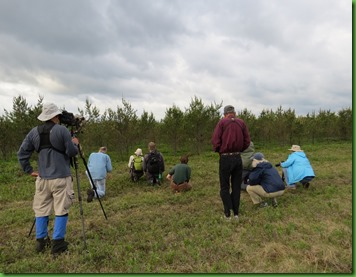






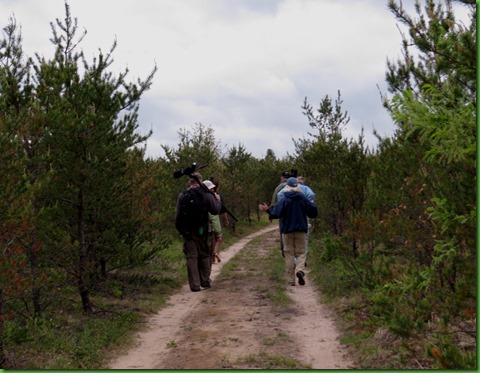
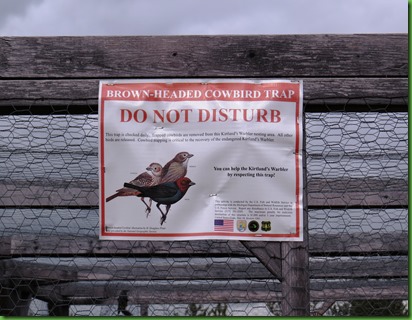


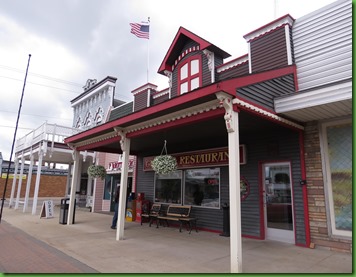



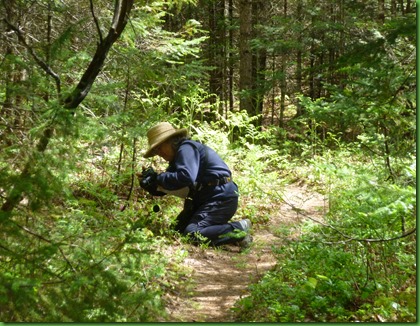






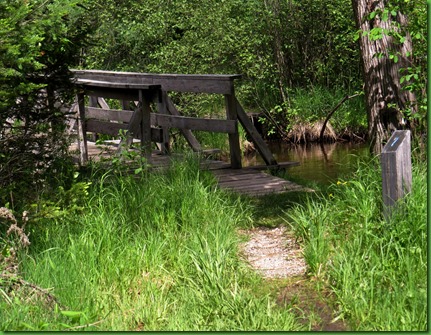
















Beautiful, wonderful area. The tallness of the trees remind me of the giant Redwoods in California.
ReplyDeleteIf you have not found a Lab yet for David in Munising, Marquette is about an hour west and will have what you are looking for. Glad you are enjoying Michigan.
ReplyDeleteGreat shots of the trees and wildflowers! I wouldn't want to deal with the mosquitos.
ReplyDeleteQuite a day! How nice that you are there for the moccasins. Those tress are really tall. We can't wait to get our travel trailer and get out on the trail!
ReplyDeleteI don't understand the reason to hike barefoot?!?!!! Glad you got a peak at the Kirtland Warbler. Getting a photograph of any warbler is a challenge!!!
ReplyDeleteYour hike reminded me of Whiteoak Sinks in GSMNP... beautiful pines, wildflowers and narrow paths:o))
In all our travels, Michigan has probably been one of the greatest surprises and your trip is reminding me how much we hope to return and explore more fully. We hiked very little and only discovered highlights. We didn't see any of the east coastline, only the UP and down the west coastline. Believe me, I'm taking notes!!
ReplyDeleteI'm so glad you got to see the Kirtland Warbler and to even get a picture. Interesting story about the cowbirds. We had one come to one or our feeders one time. We saw this tiny little mama bird feeding this big ole gray baby. I did some research and discovered what it was.
ReplyDeleteThat sure was a beautiful hike. Sorry the mosquitos are so bad. We've even been hearing about the swarms down here.
What a great day, a successful bird walk and a hike with the beautiful trees and lady slippers.
ReplyDeleteMy first instinct was to to feel sorry for the trapped cowbirds, but it seems that method is necessary so Kirtland chicks can live. Pretty bird that is...great picture you got. Wonder how they identify that there are 2000 individual singers-that must take patience!! Gorgeous hike on a gorgeous day with gorgeous flowers. Erase the mosquitos and it'd be Paradise :)
ReplyDeleteGlad you got see the Kirtland and the Lady Slippers are beautiful. Thank you for sharing your day.
ReplyDeleteDo not like the cowbirds I am glad they are trapping them. What a beautiful hike!
ReplyDeleteWonderful! Love the wildflowers, they are nature's gems. I'm not too happy with the Cowbirds either. They dominate our feeder here on the lake.
ReplyDeleteQuite the amazing efforts to control the cowbird popluation. I'm happy to hear the efforts seem to be paying off to protect the Warbler population. Thank goodness for people that take on this huge task to help the Warblers.
ReplyDeleteMaybe you should avoid washing your feet and hike barefoot. Might scare off those annoying skeeters. Seemed to work for your guide... ;c)
Trees!! Mosquito swarms - yikes :( And, sweet colorful flowers... Lovely!
ReplyDeleteMaggie
Loved the lady slippers, Those trees looked so tall and slender. I would have expected them to be much bigger around with their soaring height. Yes a good day to be alive indeed.
DeleteYou are the mosquito queen, Sherry! Nothing will stop you from exploring nature in all her glory.
ReplyDeletewow…. that looks like the clouds we had around here… black rolling thundery clouds … kinda pretty but scary
ReplyDeleteShe goes traipsing about barefooted? whoa and breakfast man? HAhaaaaa
"There isn’t much better than a dense dark forest with pink lady slippers in the dappled sunlight. Not another soul is on this trail. Lucky to be alive and here in this moment is how we feel."
sigh … love it ;)
Beautiful! And to think, we went all the way from Michigan to California to see tall trees!! OK, they're big, too! If you aren't able to get into Sleeping Bear, try Indigo Bluffs in Empire. The "rally park" is nice, and you're still really close to the national park. There is an excellent biking trail that runs from Glen Arbor, through the national park and Empire, and into the dunes . . . I think they are opening a new southern section, too, but I'm not sure how far south it goes. I think it might be called the Heritage Trail, or something like that. P.S. There's an excellent bakery in Grayling, too . . .
ReplyDeletewell. . .now you have me researching the Kirtland Warbler and their habitat. . .just in case we go exploring anywhere near where they might be. . .thanks!
ReplyDeleteSorry the mosquitoes hurried your hike. . .we were able to sit out while we were in St Clair MI, then all the sudden. . .boom. . .they were everywhere. . .you may hafta wear your bug suit, and one of those mosquito netting hats. . .now that would be a great pic. . .LOL!
Enjoy, looking forward to what else you discover. . .
Beautiful trees! And that slipper flower is just such a pretty color! Good luck finding a lab.
ReplyDeleteVirtual hugs,
Judie
Love following your adventures in Michigan. Marquette is the largest city in the UP and might have the Lab David needs.
ReplyDeleteWe were in Marquette the other day. . .that's where the ice floes were still on Lake Superior. . .very pretty place:
Deletehttp://readytogofulltimerving.blogspot.com/2014/06/ice-floes-in-june-on-lake-superior.html
You're killing me with those lady slippers! I'm hoping to see some pink ones next week in Door County, saw some yellow and white last week in Kettle Moraine. They were nowhere near as gorgeous as the ones you found though. I'll have to check out this hike someday.
ReplyDeleteI have the same expression as you when you saw the trees…Oh wow. We don't know our route yet but sure hope we can follow your tracks.
ReplyDeleteSleeping Bear Dunes- what an appealing name for a place. Makes you want to go there! I heard a piece on NPR about the Kirtland warbler. People had come from all over the world in hopes of seeing one. One guy was there with his wife and cried when they finally spotted one because he knew how much it meant to her. Still, I feel bad for the cowbirds. I guess they can't relocate them- too expensive and I suppose they would endanger other birds. The second picture of the lady slipper is beautiful. No wonder you were happy to see them. XXXOOO Pam
ReplyDeleteI love that you wrote this, "Lucky to be alive and here in this moment is how we feel." That's so often how I feel when we're in the midst of nature. Your pink lady slipper photos are gorgeous -- I hope to see those someday. What a spectacular hike! Thanks for blazing the trail for us into Michigan. :-)
ReplyDelete